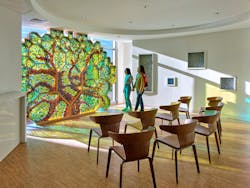Charleston’s MUSC Hospital Sets New Precedent for Inclusive, Autism-Friendly Healthcare Design
In the simplest architectural terms, the Medical University of South Carolina Shawn Jenkins Children’s Hospital and Pearl Tourville Women’s Pavilion (MUSC) is a 10-story patient tower, outfitted with a rooftop helipad and adjacent four-story diagnostic and treatment podium. There are, on the other hand, no simple terms for the interior design approach to obstetric and pediatric health and wellbeing delivered throughout the brand-new facilities.
Designed by Perkins&Will, in collaboration with associate architect McMillan Pazdan Smith Architecture, the new 625,000-square-foot facility provides integrated medical care for children, as well as obstetrical services for women. The Charleston-based hospital aims to set a new precedent for inclusive healthcare by rethinking traditional norms with a design that responds to the complex needs of patients, staff and local community. It has also become an instant leader in autism-friendly design.
“We aspired to create a spectrum-friendly hospital as seen through a full-sensory lens, that aimed to reduce environmental stressors and considered the full experiential quality for a child moving through the facility—spatial, visual, acoustical, olfactory, tactile. It aims to be a place that would be processed and understood for someone who may be under extreme stress or have heightened sensitivities to environmental stressors and comorbidities,” explained Carolyn BaRoss, healthcare interiors design director for Perkins&Will.
From the outside in, the hospital is designed to be both inclusive and joyful while supporting healing. The design team harnessed feedback from parents with children on the autism spectrum to deliver a full-sensory design response.
“It was crucial to Dr. Scheurer, MUSC’s chief medical officer, that families of patients be involved very early on,” said BaRoss of the design process. “The Patient Family Advisory Council was headed up by volunteer family members of patients involved in every step of the process and sat at the table with MUSC leadership in clinical, child life, facilities leadership and patient family advocacy.”
Patients and families provided valuable insights into the project and were able to respond to operations, layout, furnishings, theming and art, and nuanced details from small to large.
“It was a unique collaboration for its breadth and depth, and in our experience critical to understand the full design problem,” said BaRoss. “Overall, the design process for the new facility at MUSC involved a level of collaboration, honesty and empathy that is crucial to good healthcare design.”
Designing with Awareness
Perkins&Will sought to relate to children in an authentic and meaningful way, rather than project an adult’s view. The resulting space is one that avoids clichés and instead embraces a sense of wonder through discrete design interventions and soft architectural lines.
Special care and consideration were paid to remove potential triggers that could create an overwhelming environment. Instead, the design prioritizes calming the senses with a lack of visual clutter, carefully thought out travel paths, scale and lighting controls for patients to adjust as needed.
“There is not a one-size-fits-all approach because children on the spectrum do not respond in the same way or may have different needs on different days,” explained BaRoss. “There are places to play—both therapeutic and free play, to rest, to discover, to curl up with a parent, or to run around and be a child.”
[Related: How to Specify Cleanable Surfaces for Healthcare]
Aesthetically, BaRoss noted, it is the traditional children’s hospitals that feature large scale, echoing lobbies with noisy curiosities, and layers of bright pattern, shape and color, and with glaringly bright lighting and no intuitive logic to their wayfinding pathways. “All of these create opportunities to upset an already-stressed child while they are in the hospital,” she said.
A traditional hospital setting can also be cluttered, or fitted with materials, lighting and equipment that meet budgetary, operational or maintenance requirements, and may not have been selected for spectrum-friendly sensitivities.
“For example, the high-pitched hum of a fluorescent lighting ballast for someone with super-sensitive hearing can be highly stressful,” she said. “Automatic flushing or paper towel dispensers may meet certain practical needs, but can be surprising and frightening to children, so they were eliminated from bed units [in MUSC]. Also, interior products and their required cleaning solutions may be highly irritating to someone with an acute sense of smell.”
Putting the Hospital in Hospitality
To further create a space of calm and reduce environmental stressors throughout the hospital’s interior, designers worked with MUSC’s Child Life program to create a sensory room dedicated to patients on the spectrum. In addition, a roof garden/play area provides a place for children and families to connect with nature and find a place of respite.
“The Lowcountry region, city of Charleston and surrounding waterways site of this facility’s location is extraordinary for its natural beauty, architectural charm and culture,” said BaRoss. “The design team worked closely with the client team to maximize all opportunities to express this.”
The building's architecture, interiors and surrounding landscape are integrated and rooted in MUSC's theme "Stories of the Lowcountry.” The project’s color palette was coordinated inside and out, with colored light filtering through glass that emulates the beauty of the surrounding marshes. Even the base neutral color palette inside the building was informed by the sweetgrass that is woven into the famous Gullah-tradition baskets, providing a nod to Charleston’s history.
Within the hospital rooms, the use of textures and tones pays tribute to Charleston’s beach houses, creating a feeling of respite and recovery for children through simple furnishings, wood flooring and area rugs. Custom installations by local artists and craftspeople found throughout the hospital are another reminder that MUSC is rooted in Charleston’s communities.
Furthermore, the design purposefully and strategically connects the interiors with the outdoors. Patients are encouraged to find peace in the surrounding nature with the seventh-floor Child Life Play Deck while staff can retreat to the Staff Respite Terrace.
“While a very positive trend is for many more medical facilities to include beautiful healing gardens, there are not many with high-leveled, outdoor dining terraces, nor separate, offstage staff terraces that allow one to watch the sunset overlooking the beautiful waterways of Charleston and the surrounding islands,” said BaRoss. “It’s a delightful respite from the reality of being inside a hospital.”
From supporting innovative care on the inside to harnessing the healing power of nature and collaborating with the community, the new MUSC hospital goes to show that good hospitality is still a cherished Southern tradition.
Read next: Historic Library Renovation Becomes a Model for Healthy, Sustainable Design and Innovation
About the Author

Adrian Schley
Associate Editor
Adrian Schley was an Associate Editor for i+s, where she covered the commercial interior design industry since 2018. Her work can also be found in BUILDINGS and Meetings Today.
